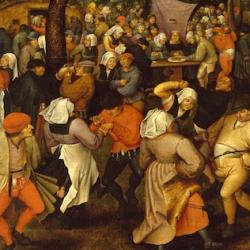“Who are these, and where have they come from?” an elder asks John about the innumerable multitude (Revelation 7:13). John answers, “You know,” and the elder does know, as he goes on to explain.
So why the pretense of ignorance?
In part, the exchange takes us back to the early chapters of John’s gospel, where Jesus describes the life of those born of Spirit. Like the wind, they are audible, but you can’t tell where they come from or where they are going (John 3). Jesus is the One born of the Spirit, as the rest of John’s gospel makes clear with its continuous repetition of the questions, “Where is He from? Where is He going?”
John doesn’t know the answer to the elder’s question, “Where did these come from?” And that hints that the multitude is a multitude born of the Spirit.
The exchange takes us further back, though. As Gregory Beale has pointed out (Revelation, 440-1), Revelation 7 contains various allusions to the LXX of Ezekiel 37, especially verses 24-26, where the Lord promises to set His sanctuary in the midst of Israel. Ezekiel 37 also starts with a Q&A: “Son of Man, can these bones live?” And Ezekiel answers, “Master Yahweh, you know” (v. 3). The answer is, Yes. As Ezekiel prophesies to the bones, they come to life by the power of the breath of Yahweh, forming a new-Adamic army.
Now we can see that the scene in Revelation 7 is layered from Ezekiel 37 and John 3. Both passages speak of the rebirth of those who are dead, and Ezekiel in particular envisions the formation of “an exceedingly great army” (37:10), perhaps even an innumerable one. The saints of Revelation 7 are martyrs who have come through tribulation. Now they have been raised up, not only with new flesh but with the glorified flesh of white robes. They form the liturgical army that Ezekiel envisioned, the new Israel born of the Spirit of which Jesus spoke.















